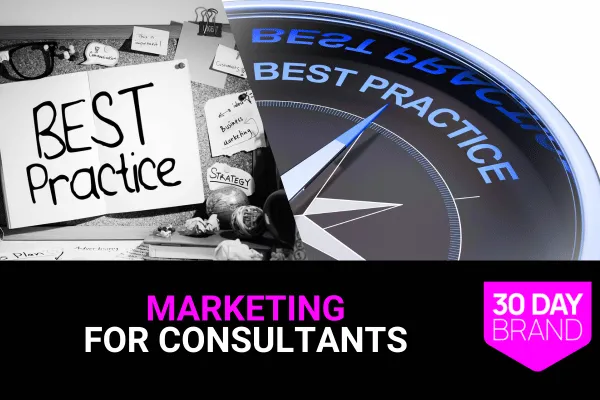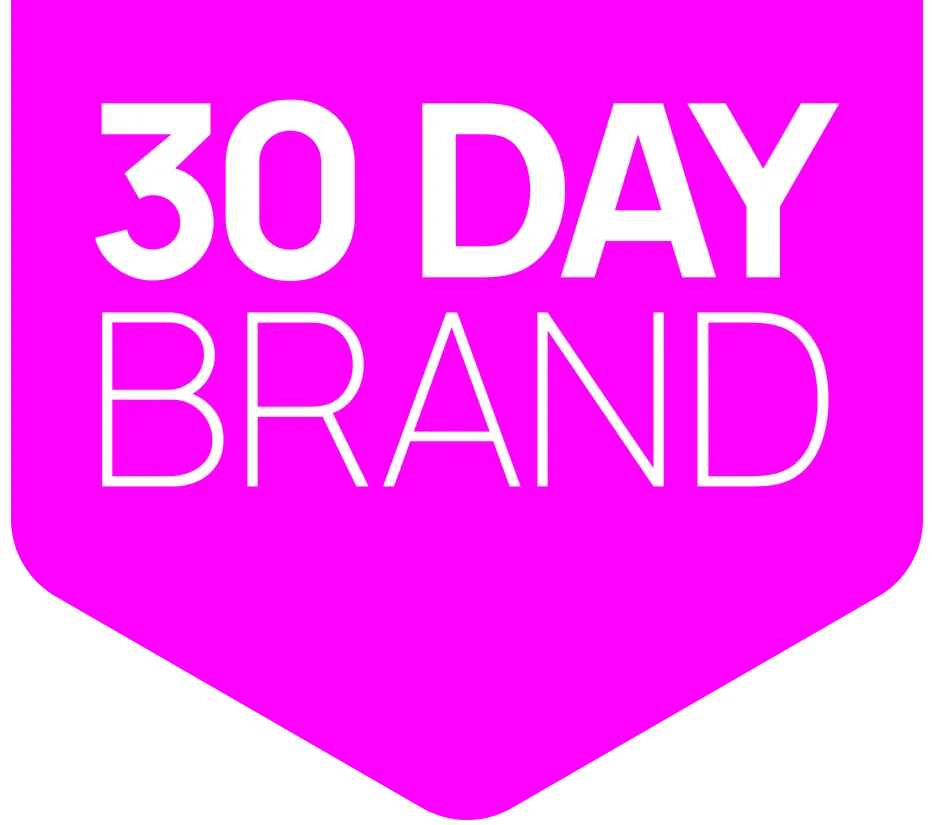
The Ultimate Guide to Marketing for Consultants: How to Attract High-Value Clients
Marketing for Consultants Overview & Definition
Marketing for consultants is the structured system that attracts, educates, and converts high-value B2B clients. It replaces outdated tactics like cold calls and networking events with authority-building and pipeline-driven strategies.
High-growth consulting firms generate 3x more leads and command 40% higher fees (Hinge Marketing, 2023). Marketing drives that growth by positioning consultants as trusted experts before prospects engage.
Who needs this: Founder-led B2B firms that want predictable pipelines, premium pricing, and freedom from feast-or-famine cycles.
Marketing for Consultants Best Practices: 12 Strategies
Most consultants rely on referrals or generic marketing. That creates price competition and unpredictable revenue. These 12 strategies show how to build authority, attract qualified buyers, and grow consistently.
Strategy 1: Authority Content System
Consultants win when prospects see them as credible teachers, not just service providers.
Definition: A structured publishing system that educates buyers and proves expertise.
How to implement:
Publish industry insights with actionable takeaways.
Create how-to guides and playbooks that solve urgent problems.
Add executive bylines to demonstrate leadership authority.
Expected result: 67% more leads from consistent publishing (CMI, 2024).
Time required: 4–6 weeks setup, then ongoing.
Learn more in our guide to B2B Branding.
Strategy 2: Thought Leadership Engine
Buyers trust consultants who shape industry conversations, not just join them.
Definition: A system for making your expertise visible in key channels.
How to implement:
Select 3–5 pillar topics your audience cares about.
Post weekly on LinkedIn with original insights.
Secure trade bylines in industry publications each month.
Expected result: 58% more leads and up to 23% higher pricing power (Edelman, 2024).
Time required: 4 weeks setup, then ongoing.
See related frameworks in the B2B Brand Messaging guide.
Strategy 3: Strategic Partnerships
Consultants grow faster when they align with trusted industry partners.
Definition: Co-marketing with platforms, associations, and integrators to extend reach.
How to implement:
Co-publish webinars and research with relevant partners.
Exchange guest content in newsletters and blogs.
List your services in partner directories and marketplaces.
Expected result: 40% more qualified leads and 25% faster growth examples (HubSpot, 2024).
Time required: 6–12 weeks.
Strategy 4: Event Marketing Excellence
Live interactions create unmatched credibility for consultants.
Definition: Targeted events that build relationships and showcase expertise.
How to implement:
Pre-book meetings with high-fit accounts before events.
Deliver focused talks or demos tailored to industry pain points.
Follow up within 48 hours with tailored content or offers.
Expected result: 70% more qualified leads from well-run events (Forrester, 2023).
Time required: 8–12 weeks.
Strategy 5: Targeted Digital Ads
Consultants who rely only on referrals miss buyers actively searching for solutions.
Definition: Precision campaigns on LinkedIn, Google, and programmatic platforms.
How to implement:
Run LinkedIn sponsored content targeting decision-maker titles.
Protect brand terms with Google Search ads.
Retarget site visitors to stay top of mind.
Expected result: 67% faster brand recognition from targeted ad campaigns (Gartner, 2024).
Time required: 2–3 weeks.
Strategy 6: SEO Pillars and Clusters
Buyers research before shortlisting consultants—search visibility determines if you get considered.
Definition: Topic clusters that win high-intent keywords and establish authority.
How to implement:
Build pillar pages covering broad, high-value topics.
Support them with cluster articles that answer specific questions.
Refresh content quarterly with updated stats and case studies.
Expected result: 53% more organic traffic and 67% more qualified leads (HubSpot, 2024).
Time required: 6–10 weeks.
See content structure examples in B2B Branding.
Strategy 7: Social Presence That Educates
Random posting doesn’t work. Smart consultants teach, not pitch.
Definition: Channel-fit content mix that builds expertise and trust.
How to implement:
Post 40% educational content, 30% thought leadership, 20% culture, 10% promo.
Encourage employee shares for added reach.
Repurpose webinars into short clips and posts.
Expected result: 78% more leads and 67% stronger recognition (CMI, 2024).
Time required: 2 weeks setup, then ongoing.
Execution details in the LinkedIn Marketing Strategy guide.
Strategy 8: Analyst and Influencer Relations
Third-party voices often carry more weight than your own marketing.
Definition: Systematic relationships with analysts and niche influencers.
How to implement:
Brief analysts quarterly with data and client results.
Co-create content with respected niche influencers.
Secure mentions in industry reports and landscape reviews.
Expected result: Up to 89% more brand mentions (Edelman, 2024).
Time required: 8–12 weeks.
Strategy 9: Customer Advocacy
Peer validation closes more consulting deals than self-promotion.
Definition: Client-driven proof programs that show results in their words.
How to implement:
Capture case studies in multiple formats (video, written, slide).
Run a reference program with ready-to-refer clients.
Host user groups and AMAs to highlight client wins.
Expected result: 70% more referrals and 56% higher client lifetime value (Forrester, 2024).
Time required: 4–8 weeks.
Strategy 10: Community Building
Consultants who create communities build loyalty and long-term visibility.
Definition: Owned or co-owned digital spaces for ongoing ICP engagement.
How to implement:
Launch a focused LinkedIn or Slack group.
Seed weekly discussions with insights and tools.
Spotlight member achievements to encourage participation.
Expected result: 92% higher retention and 67% more word-of-mouth growth (CMI, 2024).
Time required: 2–4 weeks.
Strategy 11: Press and Earned Media
Earned credibility outperforms paid ads when building trust.
Definition: Media coverage and mentions that extend reach and validate expertise.
How to implement:
Package news and data into press-friendly formats.
Pitch trade outlets with targeted stories.
Prepare spokespeople with clear talking points.
Expected result: 67% stronger recognition and 45% higher site traffic (Nielsen, 2023).
Time required: 3–6 weeks.
Strategy 12: Awareness ROI Measurement
Without measurement, consultants burn budget chasing vanity metrics.
Definition: Scorecards that connect awareness to pipeline and revenue.
How to implement:
Track recall and share of voice in your category.
Map traffic and engagement to meetings and proposals.
Attribute pipeline impact with CRM data.
Expected result: 34% higher ROI from optimized spend (McKinsey, 2023).
Time required: 1–2 weeks.
For benchmarks, see B2B Branding Best Practices.
Implementation Guide: Building Your Consulting Marketing System
Phase 1: Foundation (Months 1–3)
Step 1: Build Strategic Foundation
What to do: Define your ideal client profile, personas, and positioning.
Tools needed: Brand positioning framework, messaging map, analytics audit.
Time required: 4 weeks.
Expected result: Clear ICP, value propositions, and gap analysis.
Step 2: Establish Digital Presence
What to do: Optimize your website, LinkedIn, and email setup.
Tools needed: CMS, SEO tools, LinkedIn company page.
Time required: 4 weeks.
Expected result: Professional digital footprint that supports conversions.
Step 3: Launch Foundational Content
What to do: Publish service pages, about page, and 3–5 blogs.
Tools needed: Content calendar, writing templates.
Time required: 3–4 weeks.
Expected result: Authority-building base content.
Phase 2: Growth and Optimization (Months 4–9)
Step 4: Build Authority
What to do: Publish case studies, thought leadership, and webinar series.
Tools needed: Case study templates, webinar platform, CRM.
Time required: 3 months.
Expected result: Rising trust and inbound lead flow.
Step 5: Scale Lead Generation
What to do: Add outbound campaigns, SEO pillars, and digital ads.
Tools needed: LinkedIn Sales Navigator, ad manager, SEO suite.
Time required: 3 months.
Expected result: Predictable qualified pipeline.
Phase 3: Systematization and Scale (Months 10–12)
Step 6: Optimize and Automate
What to do: Analyze data, refine tactics, and automate nurture flows.
Tools needed: Marketing automation, dashboards, analytics tools.
Time required: 3 months.
Expected result: Compounding gains and lower cost per client.
Metrics & Measurement for Consulting Marketing
Marketing ROI for consultants comes from quality, not vanity metrics. Track what ties directly to revenue.
Lead Generation Metrics
Marketing Qualified Leads (MQLs): Prospects that match ICP and engage with content.
Sales Qualified Leads (SQLs): Buyers ready for sales conversations.
Lead-to-Client Conversion Rate: % of leads that become paying clients.
Cost Per Lead: Average marketing cost per qualified lead.
Pipeline Metrics
Pipeline Value: Total projected value of active opportunities.
Sales Cycle Length: Average days from first touch to signed agreement.
Win Rate: % of proposals that close.
Average Deal Size: Mean value of engagements.
Business Impact Metrics
Revenue Growth: Year-over-year consulting revenue increase.
Client Lifetime Value (CLV): Total financial value of each client.
Profit Margin: % profit from marketing-generated clients.
Market Share: Position relative to direct competitors.
Benchmark Data
67% of B2B buyers complete research before contacting vendors (HubSpot, 2024).
High-growth consulting firms generate 3x more leads (Hinge, 2024).
Strong brands command 40% higher fees (Hinge, 2024).
Consistent brand presentation increases revenue by up to 23% (Lucidpress, 2021).
Data-driven firms achieve 67% higher ROI (McKinsey, 2023).
FAQ: Marketing for Consultants
Q: How fast can marketing impact revenue?
A: Early results appear in 90 days. Significant ROI takes 6–12 months (Forrester, 2024).
Q: What’s the #1 mistake consultants make?
A: Generic marketing. It dilutes expertise and forces price competition.
Q: Should consultants rely on referrals?
A: No. Referrals are unpredictable. A systemized pipeline creates stability.
Q: How much should consultants invest in marketing?
A: 15–25% of revenue is typical for high-growth firms (Gartner, 2024).
Q: What type of content works best?
A: Case studies, frameworks, and educational articles build trust and generate qualified leads.
Q: Is LinkedIn worth the focus?
A: Yes. LinkedIn drives the highest-quality B2B consulting leads (LinkedIn, 2024).
Q: Should consultants gate content?
A: Gate assessments and deep guides. Keep primers open for visibility.
Q: How do you prove credibility digitally?
A: Use testimonials, quantified client results, and thought leadership content.
Q: Do small firms need different marketing?
A: No. The same systems work—smaller firms just focus narrower for faster impact.
Q: How do I know if marketing is working?
A: Track pipeline value, win rate, and sales cycle reduction monthly.
Let’s Build Your Consulting Pipeline
Most consultants lose revenue because their marketing is inconsistent or unclear. A strong system changes that.
Run the free Brand Message Audit to see where your marketing creates confusion and how to fix it in minutes.










